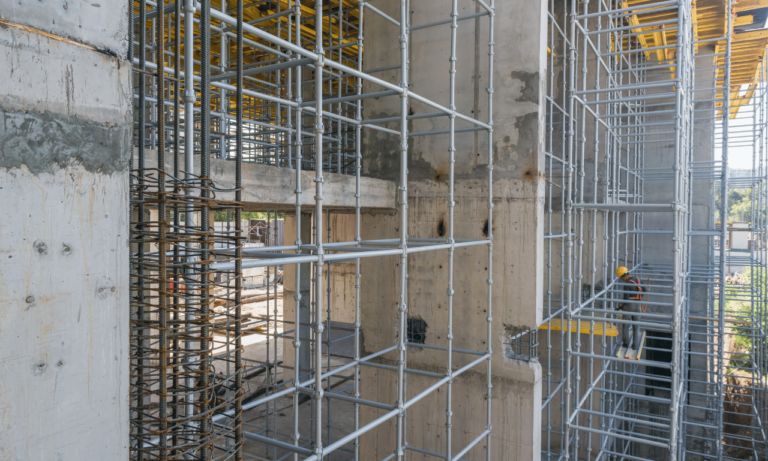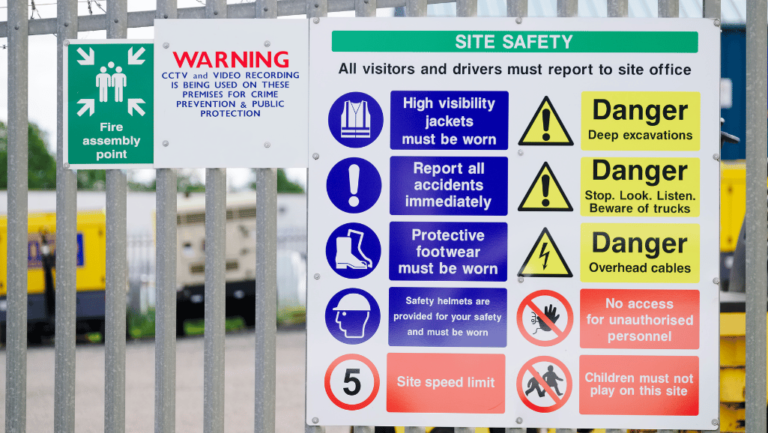Phone:
(+65)8319-0742
In this comprehensive guide, we will explore the essential elements of scaffolding permit-to-work systems. We will examine the importance of these systems in enhancing compliance with safety regulations in construction projects. Additionally, we will discuss the role of construction permit software and the significance of scaffold inspection checklists in ensuring a safe work environment.
Scaffolding permit-to-work systems are a vital component of construction projects, ensuring the safety of workers and compliance with safety regulations. By implementing these systems, construction professionals can create a secure work environment and mitigate potential risks associated with scaffolding operations.
Key Takeaways:
- Scaffolding permit-to-work systems are crucial for safety and compliance in construction projects.
- Construction permit software plays a significant role in managing permit-related activities.
- Scaffold inspection checklists help identify potential hazards and maintain the structural integrity of scaffolds.
- Compliance with safety regulations is essential for worker well-being and project success.
- Adopting digital solutions streamlines the permit-to-work process and improves efficiency.
Understanding Scaffolding Permit-to-Work Systems
Scaffolding permit-to-work systems play a critical role in ensuring the safety of workers when engaging in work at height. By understanding the fundamentals of these systems, construction professionals can effectively manage and mitigate risks associated with working at heights.
Obtaining work at height permits is a key requirement in scaffolding operations. These permits are necessary to authorize workers to carry out tasks at elevated levels. They serve as an acknowledgement that the necessary safety procedures and precautions are in place to protect workers from potential hazards.
Safety procedures form an integral part of scaffolding permit-to-work systems. They outline the necessary steps and protocols that must be followed to maintain a safe work environment. This includes the proper use of Personal Protective Equipment (PPE), secure assembly and dismantling of scaffolds, and adherence to industry-specific safety guidelines.
By implementing robust scaffolding permit-to-work systems, construction professionals can ensure that all work at height permits are obtained in accordance with safety regulations. This helps to mitigate the risks associated with working at heights and promotes a culture of safety and compliance within construction projects.
The Importance of Work at Height Permits
Work at height permits are crucial in managing the risks involved with working at elevated levels. These permits ensure that necessary safety precautions are in place before commencing any tasks that involve working at heights.
Work at height permits typically require the identification of hazards, evaluation of risk levels, and the implementation of suitable control measures. Construction professionals must also conduct regular inspections and audits to ensure ongoing compliance with safety regulations.
Furthermore, work at height permits facilitate effective communication and coordination among project stakeholders. They provide a standardized process for obtaining authorization, ensuring that all parties are aware of the tasks being carried out, the associated risks, and the necessary safety protocols.
The Role of Safety Procedures
Safety procedures are essential components of scaffolding permit-to-work systems. These procedures outline the necessary precautions and best practices that must be followed to ensure a safe working environment.
These procedures typically include guidelines for conducting proper risk assessments, ensuring the use of suitable fall protection systems, maintaining proper scaffold stability, and securing scaffolding equipment to prevent accidental dislodgment.
By strictly adhering to safety procedures, construction professionals can mitigate the risks associated with working at heights. This not only protects the well-being of workers but also helps to prevent accidents, injuries, and property damage.
Ensuring Compliance and Safety
Compliance with safety procedures and obtaining work at height permits is crucial to maintaining a safe work environment. Construction professionals must prioritize safety by establishing clear guidelines and providing comprehensive training to all workers involved in scaffolding operations.
Utilizing construction permit software can greatly streamline the management of scaffolding permits and safety procedures. This digital solution automates the permit-to-work process, ensuring that all necessary documentation and approvals are obtained in a timely manner.
By implementing and consistently following scaffolding permit-to-work systems, construction projects can foster a culture of safety, minimize risks, and promote the well-being of workers in work-at-height environments.
Importance of Safety Regulations Compliance
Safety regulations compliance is of paramount importance in the construction industry to safeguard the well-being of workers and ensure the smooth execution of projects. Adhering to stringent safety regulations, especially when it comes to scaffolding, plays a crucial role in maintaining a secure work environment.
Compliance with safety regulations involves rigorously following established scaffolding safety procedures and guidelines. These procedures outline the necessary precautions and measures to minimize the risk of accidents and injuries. By strictly adhering to these safety protocols, construction professionals can create a culture of safety and foster a work environment that prioritizes the well-being of all workers involved.
Enhancing Safety with Digital Permit Systems
One way to streamline safety regulations compliance is through the adoption of digital permit systems. These innovative solutions digitize and automate the permit-to-work process, replacing traditional paper-based systems. With digital permit systems, construction teams can centralize permit management, track compliance requirements, and ensure that all necessary permits are obtained before commencing work.
âDigital permit systems streamline compliance, enhance communication, and simplify the issuance of scaffold access permits.â
Digital permit systems also enable real-time monitoring and reporting, providing better visibility and control over safety-related activities. By leveraging these systems, construction companies can significantly reduce the administrative burden and mitigate the risk of non-compliance with safety regulations.
Furthermore, digital permit systems facilitate the creation and management of comprehensive digital audit trails, making it easier to demonstrate compliance during regulatory inspections. These systems can provide quick access to historical permit data, allowing construction professionals to assess past safety compliance performance and make informed decisions for continual improvement.
Creating a Comprehensive Safety Culture
While digital permit systems play a crucial role in ensuring safety regulations compliance, fostering a comprehensive safety culture is equally important. This involves promoting safety awareness among all stakeholders, from workers to project managers and supervisors. Regular safety training programs should be conducted to educate employees on scaffolding safety procedures, hazard identification, and risk mitigation strategies.
From conducting toolbox talks to implementing safety orientations, construction companies must invest in ongoing safety training initiatives. These initiatives should be tailored to address specific challenges and risks associated with scaffolding work. By creating a well-informed and safety-conscious workforce, construction projects can minimize the occurrence of accidents and promote a culture of safety.
Implementing an Effective Scaffolding Inspection Checklist
A robust scaffolding inspection checklist is crucial for identifying potential hazards and ensuring the structural integrity of scaffolds. By employing a thorough checklist, construction professionals can proactively address safety concerns and mitigate risks in their projects. This section will examine the key components of an effective checklist and highlight the role of construction permit software in streamlining inspection management.
The Key Components of an Effective Scaffolding Inspection Checklist
An effective scaffolding inspection checklist should encompass comprehensive assessments of various components, including:
- Scaffold design and construction
- Foundations and base plates
- Guardrails, toeboards, and handrails
- Access points and ladders
- Platform integrity
- Load-bearing capacity
- Tie-ins and bracings
- Safe working zones and clearances
- Weather conditions and environmental factors
- Regular maintenance and repairs
By thoroughly examining these aspects, construction professionals can identify any potential issues, such as weak points in the scaffold structure or missing safety features, before they pose a threat to worker safety.
The Role of Construction Permit Software in Streamlining Inspection Management
Managing scaffold inspections and keeping track of the checklist’s completion can be a complex task. However, with the aid of construction permit software, construction professionals can seamlessly oversee and monitor inspection processes. This software provides a centralized platform for documenting inspection results, scheduling follow-up actions, and ensuring compliance with safety regulations.
By implementing a permit management solution within the construction permit software, construction professionals can optimize workflow integration. This solution allows for streamlined coordination between inspection teams, project managers, and relevant stakeholders, ensuring smooth and efficient operations.
With the aid of construction permit software and a well-designed scaffold inspection checklist, construction projects can enhance safety standards, minimize risks, and create a secure work environment for all involved.
Streamlining Permit-to-Work Processes with Digital Solutions

In today’s digital age, implementing digital permit systems has become increasingly essential for streamlining the permit-to-work process. This is particularly true in the context of scaffolding operations, where efficient management of scaffold access permits is crucial. By leveraging the power of construction permit software, construction professionals can enhance efficiency, improve communication, and simplify the issuance of permits.
One of the primary benefits of adopting digital permit systems is the significant improvement in workflow efficiency. With traditional paper-based systems, managing permits can be a time-consuming and error-prone process. However, construction permit software automates and digitizes the entire workflow, eliminating manual errors and reducing administrative burdens.
By centralizing all permit-related activities, construction permit software ensures seamless integration and comprehensive monitoring. Project managers can easily track the status of scaffold access permits, review permit details, and ensure compliance with safety regulations. This real-time visibility enables proactive decision-making and enhances overall project management.
Furthermore, digital permit systems improve communication and collaboration among stakeholders involved in the permit-to-work process. Notifications and alerts can be instantly shared, ensuring that all parties are informed and aware of any changes or updates. This streamlined communication fosters better coordination, reduces delays, and enhances overall productivity on construction sites.
Issuing scaffold access permits becomes simplified with digital permit systems. Instead of physically distributing permits, construction professionals can utilize secure digital platforms to issue permits electronically. This eliminates the need for manual paperwork and reduces the risk of lost or misplaced permits. Additionally, digital permits can be easily accessed on mobile devices, enhancing convenience and accessibility for workers on-site.
In summary, the adoption of digital permit systems offers significant advantages in streamlining the permit-to-work process for scaffolding operations. By leveraging construction permit software, construction professionals can improve efficiency, enhance communication, and simplify the issuance of scaffold access permits. With real-time monitoring and seamless integration, projects can ensure compliance with safety regulations while maximizing productivity.
| Benefits of Digital Permit Systems for Scaffolding Operations |
|---|
| Enhanced workflow efficiency |
| Improved communication and collaboration |
| Simplified issuance of scaffold access permits |
| Real-time monitoring and comprehensive tracking |
| Reduced administrative burdens and manual errors |
Enhancing Safety Awareness and Training

In any scaffolding operation, prioritizing safety awareness and providing comprehensive training programs are crucial for ensuring compliance with safety regulations. By equipping workers with the necessary knowledge and skills, construction companies can create a safety-focused work culture where every worker understands and follows scaffold safety procedures. Moreover, incorporating work at height permits into the training process further reinforces the importance of adhering to safety regulations and mitigating risks.
To foster safety awareness, construction companies should implement comprehensive training programs that cover various aspects of scaffolding operations. These programs can include classroom sessions, hands-on training, and practical demonstrations to ensure that workers understand the risks associated with working at heights and are proficient in using safety equipment.
Additionally, continuous safety updates and refresher courses should be provided to keep workers informed about the latest safety regulations and best practices. By staying up to date with safety guidelines, workers can adapt to any changes in safety regulations, ensuring ongoing compliance.
Work at height permits are an integral part of scaffolding operations, as they not only ensure legal compliance but also demonstrate a commitment to worker safety. These permits are typically obtained before starting any work at height and require a thorough assessment of risks and implementation of appropriate safety measures.
The Role of Work at Height Permits
Work at height permits serve as a formal authorization to carry out tasks at elevated positions and help in identifying potential hazards and implementing necessary control measures. These permits also help establish a clear communication channel between workers, supervisors, and safety officers regarding the specific activities to be performed, the required safety measures, and emergency procedures.
By integrating work at height permits into safety training programs, construction companies can emphasize the importance of following safety regulations and foster a safety-conscious work culture. It instills a mindset where workers actively prioritize safety and take collective responsibility for reducing risks.
Overall, by enhancing safety awareness through comprehensive training programs and incorporating work at height permits into scaffold operations, construction companies can ensure compliance with safety regulations and create a secure work environment for their workers.
| Benefits of Enhancing Safety Awareness and Training |
|---|
| 1. Reduced risk of accidents and injuries |
| 2. Compliance with safety regulations |
| 3. Improved safety culture and worker engagement |
| 4. Increased productivity due to reduced downtime from accidents |
| 5. Enhanced reputation and credibility as a safety-conscious company |
Best Practices for Scaffolding Permit-to-Work Systems

Implementing best practices for scaffolding permit-to-work systems is crucial for maintaining safety and compliance on construction projects. By following key safety procedures, utilizing digital permit systems, and leveraging construction permit software, construction professionals can ensure a secure work environment. Here are some essential best practices to consider:
1. Conduct Comprehensive Risk Assessments
Prior to starting any scaffolding work, it is important to conduct thorough risk assessments to identify potential hazards and determine appropriate safety measures. Assessing factors such as the height of the scaffolding, load capacity, and environmental conditions helps in creating a safe work plan.
2. Provide Adequate Training and Supervision
Ensure that workers involved in scaffolding operations receive proper training on safety procedures, including the correct assembly, dismantling, and usage of scaffolds. Regularly supervise and monitor workers’ adherence to safety protocols to prevent accidents and ensure compliance.
3. Implement a Scaffold Inspection Checklist
Utilize a scaffold inspection checklist to ensure the regular inspection of scaffolding structures. The checklist should encompass visual checks, structural integrity assessments, and equipment functionality verifications. Consistent inspections help identify potential issues and prevent accidents.
| Benefits of Scaffold Inspection Checklists | |
|---|---|
| 1. Ensures compliance with safety regulations. | 2. Identifies potential hazards before they lead to accidents. |
| 3. Promotes a culture of safety awareness among workers. | 4. Facilitates maintenance and repairs. |
4. Utilize Digital Permit Systems
Adopting digital permit systems streamlines the permit-to-work process. These systems provide a centralized platform for managing permits, enhancing communication, and ensuring accurate record-keeping. Digital permit systems also allow for real-time monitoring of permit-related activities, improving efficiency and compliance.
5. Leverage Construction Permit Software
Construction permit software complements digital permit systems by offering advanced features such as automated workflows and task management. This software enables seamless integration of permit-related activities with overall project management, enhancing coordination and minimizing delays.
By implementing these best practices, construction projects can prioritize safety, prevent accidents, and ensure compliance with safety regulations. Scaffolding permit-to-work systems combined with digital solutions and comprehensive safety procedures lay the foundation for a secure and successful construction project.
Conclusion
In conclusion, the implementation of scaffolding permit-to-work systems is crucial in the construction industry for enhancing safety and ensuring compliance with regulations. By leveraging digital solutions and utilizing scaffold inspection checklists, construction professionals can effectively mitigate risks and create a secure work environment.
Compliance with safety regulations not only safeguards the well-being of workers but also contributes to the successful completion of projects. By fostering a culture of safety awareness and providing comprehensive training programs, construction companies can prioritize the protection of their workforce.
Through the utilization of digital permit systems and construction permit software, the permit-to-work processes can be streamlined, facilitating efficient communication and seamless integration of permit-related activities. These systems also enable better monitoring and management of scaffold access permits, simplifying the overall workflow.
FAQ
What are scaffolding permit-to-work systems?
Scaffolding permit-to-work systems are processes and procedures put in place to ensure the safe and compliant use of scaffolding in construction projects. These systems involve obtaining permits, conducting inspections, and implementing safety measures to mitigate risks associated with working at heights.
Why are scaffolding permit-to-work systems important?
Scaffolding permit-to-work systems are important because they help construction companies comply with safety regulations and ensure the well-being of workers. By implementing these systems, companies can minimize accidents, prevent structural failures, and create a safer work environment for all involved.
How can construction permit software help with scaffolding permits?
Construction permit software can streamline the process of obtaining scaffolding permits by automating the application and approval process. This software allows project managers to track permit status, manage documentation, and ensure that all necessary permits are obtained before commencing work.
What is the purpose of a scaffold inspection checklist?
A scaffold inspection checklist serves as a tool for identifying potential safety hazards and ensuring the proper functioning and stability of scaffolding structures. It covers areas such as guardrails, bracing, access points, and load capacity, allowing inspectors to thoroughly assess the safety of the scaffolding before workers begin using it.
How can a permit management solution improve scaffolding operations?
A permit management solution can improve scaffolding operations by providing a centralized platform to manage and track all permits and associated documentation. This solution streamlines the permit-to-work process, enhances communication between stakeholders, and ensures that permits are obtained and renewed in a timely manner.
What are digital permit systems, and how do they benefit scaffolding operations?
Digital permit systems are electronic platforms that digitize the permit-to-work process. These systems replace traditional paper-based permits with digital permits that can be electronically issued, monitored, and tracked. Digital permit systems offer benefits such as improved efficiency, real-time communication, and easier access to permit information, enhancing the overall safety and effectiveness of scaffolding operations.
What are scaffold access permits and why are they important?
Scaffold access permits are specific permits that authorize individuals to access and work on scaffolding structures. These permits ensure that only qualified and trained personnel are allowed to use the scaffolding, reducing the risk of accidents and maintaining safety standards. Scaffold access permits also help track who is authorized to work at height, allowing for better control and accountability.
How can work at height permits contribute to a safety-focused work culture?
Work at height permits play a crucial role in fostering a safety-focused work culture by ensuring that workers are aware of the risks associated with working at heights and are equipped with the necessary training and protective measures. These permits require workers to adhere to safety procedures and best practices, promoting a culture of safety awareness and responsible behavior.



















